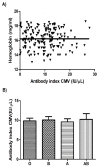Human Cytomegalovirus Seroprevalence Among Blood Donors in the Madinah Region, Saudi Arabia
- PMID: 35265404
- PMCID: PMC8897812
- DOI: 10.7759/cureus.21860
Human Cytomegalovirus Seroprevalence Among Blood Donors in the Madinah Region, Saudi Arabia
Abstract
Background and objective Human cytomegalovirus (HCMV), a double-stranded DNA virus of the Herpesviridae family, can remain latent for long periods of time. HCMV may cause severe illness in immunocompromised patients and is associated with congenital anomalies. This study aimed to determine the anti-HCMV immunoglobulin G (IgG) and IgM antibody seroprevalence among blood-donating Saudi men in the Madinah region. Methods A total of 375 blood-donating Saudi men were recruited from the Central Blood Bank in Madinah, the Kingdom of Saudi Arabia (KSA), and stratified into three age groups: 18-30, 31-40, and 41-61 years. Anti-HCMV IgG and IgM antibody levels were measured by enzyme-linked immunosorbent assay (ELISA). Pearson's correlation coefficient was used to correlate antibody levels with variables. Results Most of the tested samples (95.73%, n=356) were positive for anti-HCMV IgG antibodies, but only 1.6% (n=6) were positive for both IgM and IgG antibodies, and all of them belonged to the age groups of 31-40 and 41-61 years. A strong inverse correlation was found between anti-HCMV IgG antibody levels and age (r=-0.51, p<0.0001). Additionally, there was an inverse correlation between anti-HCMV IgG antibody levels and body mass index (BMI) (r=-0.11, p=0.036). No correlations were found between anti-HCMV IgG levels and hemoglobin levels or blood groups of the participants. Conclusions Blood-donating Saudi men in Madinah had a high seroprevalence of anti-HCMV IgG antibodies, indicating previous viral exposure. Age and BMI might influence the humoral immunologic memory response against HCMV, which appears to be endemic in Madinah.
Keywords: blood donors; hcmv; immunocompromised; madinah; seroprevalence.
Copyright © 2022, Mahallawi et al.
Conflict of interest statement
The authors have declared that no competing interests exist.
Figures




Similar articles
-
Natural immunity to influenza A and B among Saudi blood donors in Al Madinah Al Munawarah, Saudi Arabia.Saudi Med J. 2020 Dec;41(12):1301-1307. doi: 10.15537/smj.2020.12.05582. Saudi Med J. 2020. PMID: 33294887 Free PMC article.
-
The seroprevalence of SARS-CoV-2 IgG antibodies among asymptomatic blood donors in Saudi Arabia.Saudi J Biol Sci. 2021 Mar;28(3):1697-1701. doi: 10.1016/j.sjbs.2020.12.009. Epub 2020 Dec 11. Saudi J Biol Sci. 2021. PMID: 33519277 Free PMC article.
-
Screening of blood donors for human cytomegalovirus (HCMV) IgG antibody with an enzyme immunoassay using recombinant antigens.J Clin Virol. 1999 Dec;14(3):173-81. doi: 10.1016/s1386-6532(99)00060-8. J Clin Virol. 1999. PMID: 10614854
-
Seroprevalence of brucellosis among high-risk individuals in Madinah, Saudi Arabia.Vet World. 2024 Aug;17(8):1661-1666. doi: 10.14202/vetworld.2024.1661-1666. Epub 2024 Aug 3. Vet World. 2024. PMID: 39328429 Free PMC article.
-
Humoral immune response to human cytomegalovirus infection: diagnostic potential of immunoglobulin class and IgG subclass antibody response to human cytomegalovirus early and late antigens.Clin Investig. 1993 Apr;71(4):270-6. doi: 10.1007/BF00184725. Clin Investig. 1993. PMID: 8386033 Review.
Cited by
-
Prevalence and investigation of Cytomegalovirus (HCMV) in blood donors from the main blood establishment in Rio de Janeiro/Brazil.Braz J Infect Dis. 2025 Mar-Apr;29(2):104508. doi: 10.1016/j.bjid.2025.104508. Epub 2025 Feb 7. Braz J Infect Dis. 2025. PMID: 39922051 Free PMC article.
-
Cytomegalovirus and Epstein-Barr virus infections among Jordanians: seroprevalence and associated factors.BMC Infect Dis. 2025 May 21;25(1):724. doi: 10.1186/s12879-025-11110-2. BMC Infect Dis. 2025. PMID: 40399872 Free PMC article.
References
-
- Cytomegalovirus in liver transplant recipients. Herman D, Han H. Curr Opin Organ Transplant. 2017;22:345–350. - PubMed
-
- Cytomegalovirus. Taylor GH. https://pubmed.ncbi.nlm.nih.gov/12588074/ Am Fam Physician. 2003;67:519–524. - PubMed
LinkOut - more resources
Full Text Sources
